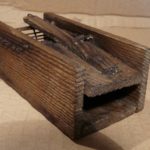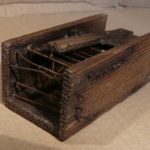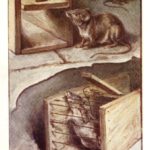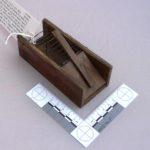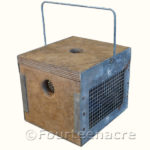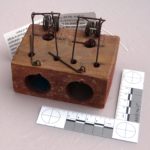Description
This little One Fall mouse trap was made in enormous numbers in the last quarter of the 19th century – and probably earlier. It is also sometimes referred to as the ‘common’ trap or the ‘penny’ mouse trap as they cost about one penny each.
In use, the end-flap arm is lightly set under the bait hook wire. When the bait is disturbed the end-flap quickly closes under the influence of two small coiled torsion springs. It is made of softwood with wire bars across the top and end. Various makers. Size: 4⅞” x 2⅛” x 1¾”.
1 July 2011
One of the things that we have enjoyed most about this Vintage Trap Museum is the level of interest it’s created with our customers. I am indebted to Nigel who has sent me a copy of book of English Composition exercises for Children, dated 1910. The book is filled with pictures of events and scenarios that children would be familiar with, each accompanied by a series of questions and tasks for children to write about. Included in the book is this illustration; clearly a trap of the same design and what must have been a common site during this period.
28 August 2011
There is even more follow up on this, from Alan Lancashire who posted on our Facebook page. Alan wrote “the story of a penny mouse trap maker can be found in Henry Mayhew’s London Labour And The London Poor, Volume 3. The description of the traps he makes match this trap almost perfectly.”
Having followed it up I completely agree with Alan – there’s an online copy of the full text which you can read in Tufts Digital Library but I’ve included the most relevant excerpt below.
“I think I have made, altogether, about one hundred and six gross of mouse-traps for the master whose account I have given you, and as many more for other employers, in the course of the last year. I calculate that I made more than thirty thousand mouse-traps from January to December, 1849 . There are three or four other people in London making penny mouse-traps, besides myself. I reckon they may make among them near upon half as many as I do; and that would give about forty-five or fifty thousand penny mouse-traps made in London in the course of the year. I myself brought out the penny mouse-trap in its improved shape, and with the improved lever spring. I have no calculations as to the number of mice in the country, or how soon we should have caught them if we go on at this rate; but I think my traps have to do with that. They are bought more for toys than for use, though they are good for mice as well as children; and though we have so many dozen mousetraps about the house, I can assure you we are more troubled with mice here than most people. The four of us here can make twenty-four dozen traps in the day, but that is all we can get through comfortable. For eighteen dozen we get about 10 s. at the warehouse, and out of that I reckon our clear gains are near upon 4 s., or a little less than 1 s. a head. Take one with the other, we can earn about a penny an hour; and if it wasn”t for me having been a tailor originally, and applying some of my old tools to the business, we shouldn”t get on so quick as we do. With my shears I can cut twenty-four wires at a time, and with my thimble I thread the wires through the holes in the sides. I make the springs, cut the wires, and put them in the traps. My daughter planes the wood and gauges out the sides and bottom, bores the wire-holes and makes the door as well. My wife nails the frames ready for wiring, and my son fixes the wires in their places when I have entered them; then the wife springs them, after which the daughter puts in the doors and so completes them. I can”t form an idea as to how many penny and halfpenny money-boxes I made last year. I might have made, altogether, eight thousand, or five thousand halfpenny and three thousand penny ones.”
- The Open end of the ‘One Fall’ Mouse Trap
- one fall closed end

